Abstract
The current need to reduce carbon emissions makes hydrogen use essential for self-consumption in microgrids. To make a profitability analysis of a microgrid, the influence of equipment costs and the electricity price must be known. This paper studies the cost-effective electricity price (EUR/kWh) for a microgrid located at ‘’La Rábida Campus’’ (University of Huelva, south of Spain), for two different energy-management systems (EMSs): hydrogen-priority strategy and battery-priority strategy. The profitability analysis is based, on one hand, on the hydrogen-systems’ cost reduction (%) and, on the other hand, considering renewable energy sources (RESs) and energy storage systems (ESSs), on cost reduction (%). Due to technological advances, microgrid-element costs are expected to decrease over time; therefore, future profitable electricity prices will be even lower. Results show a cost-effective electricity price ranging from 0.61 EUR/kWh to 0.16 EUR/kWh for hydrogen-priority EMSs and from 0.4 EUR/kWh to 0.17 EUR/kWh for battery-priority EMSs (0 and 100% hydrogen-system cost reduction, respectively). These figures still decrease sharply if RES and ESS cost reductions are considered. In the current scenario of uncertainty in electricity prices, the microgrid studied may become economically competitive in the near future.
1. Introduction
As a result of climate change and air pollution, the need to implement policies for the reduction of anthropogenic greenhouse gas emissions is evident [1,2]. In this respect, renewable energy sources (RESs) play an essential role in replacing fossil fuels [1], which are associated with high greenhouse gas emissions and are expected to be depleted in the near future [3,4]. However, RESs are not always available, due to their intermittency [5,6]. For this reason, it is necessary to implement systems to store the energy excess produced by RESs, like battery- or hydrogen-storage systems. In this way, the stored energy can be used when energy demand is higher than energy production [7,8,9].
However, the current costs of storage systems are very high [10]. In particular, for hydrogen-storage systems, which in addition to the storage tank, require a hydrogen-production system, such as an electrolyser, and a system to transform the chemical energy of hydrogen into electrical energy, such as a fuel cell. But the fees associated with RESs and energy storage systems (ESSs) (hydrogen and battery systems) are observed to be decreasing over time [11,12]. This tendency is of vital importance in order to guarantee the implementation of self-consumption systems, since from an economic perspective a reduction of economic subsidies implies improved profitability. In this sense, a significant reduction in subsidies that is needed for PV panels can be found in the literature [13]. On the other hand, it can also be found that green hydrogen could be economically competitive with hydrogen produced from steam-methane reformation [14] or a quick and significant reduction in the costs of Li-ion batteries [15]. To make RESs and storage systems economically competitive for self-consumption, there are different proposals that can be classified between the following: (1) Those focused on the energy-management strategy (EMS), such as a mixed-integer linear-programming (MILP) model to minimise the operating cost of a microgrid [16], or the use of a deep deterministic policy-gradient algorithm in order to reduce microgrid operating costs [17]. (2) Those based on the use of low-cost materials and equipment for the microgrid, such as the use of a photoluminescent (PL) absorber of luminescent solar power (LSP) to reduce solar-PV energy costs [18], or the use, in redox flow batteries (RFBs), of low-cost polymeric redox-active materials and porous size-exclusion membranes of commodity polymers instead of more expensive options like inorganic redox-active materials and ion-exchange membranes, respectively [19].
Based on the above, most previous works seek to reduce the costs or optimise the benefits of the microgrid, but very few references study the influence of electricity prices on the profitability of a hydrogen-based microgrid. Among the references analysed, Krajačić et al. [20] conducted a study of the influence of RESs and ESSs (including hydrogen systems) on the price of electricity on an island. Grosspietsch et al. [21] study the profitability of different microgrid configurations composed, on the one hand, of solar PV panels and batteries and, on the other hand, of solar PV panels, batteries and hydrogen-based systems, in both cases as functions of the cost reduction (%) of the technologies for all elements, and the increase in the electricity price (%). On the other hand, Mah et al. [22] study the levelised cost of energy (LCOE) based on two EMSs and the cost reduction of different technologies that make up the microgrid; however, it does not take into account the electricity price to assess the economic analysis of the microgrid. Vincent et al. [23] perform an economic analysis based on the electricity price of a microgrid which does not include hydrogen systems. Similarly, Azimian et al. [24] consider a microgrid without hydrogen systems, in which the profitability is studied based on the increase of the electricity price. Finally, Eskander et al. [25] study the influence of electricity price on the profitability of different configurations of a microgrid. However, none of the references consulted estimates the price of electricity at which the microgrid becomes economically competitive.
This paper studies the cost-effectiveness of a hydrogen-based microgrid, an analysis which, in turn, will contribute to the development of insights and recommendations for the deployment of these microgrids in various energy-market contexts. The study focuses on two EMSs: hydrogen-priority strategy and battery-priority strategy. First, it assesses their performance over a range of electricity prices, from 0.01 EUR/kWh to 3 EUR/kWh, and a cost reduction of hydrogen-based systems from 0% to 100%. Finally, the analysis includes a third variable, that will be the cost reduction of RESs (wind energy and solar PV) and batteries, ranging from 0% to 100%. Thus, this research provides a starting point for further research on the influence of the implemented EMS on the profitability of these microgrids. With respect to the analysed literature [21,22,23,24,25], the research gap addressed in this paper is that it estimates, for a hydrogen-based microgrid, the electricity price at which the microgrid becomes profitable based on two EMSs and as a function of the cost reduction of the microgrid equipment (hydrogen-based systems on the one hand and the rest of renewable-origin equipment on the other hand). Table 1 summarises the main novelties of this paper with respect to the analysed literature.

Table 1.
Main contributions of authors’ proposal regarding the scientific literature.
2. Materials and Methods: Description of the Microgrid and the Implemented EMS
To develop the profitability analysis, the authors rely on the hydrogen-based microgrid (which includes RES production and a hybrid ESS consisting of a hydrogen subsystem and a battery bank) represented in Figure 1, that is located at the “La Rábida Campus” of the University of Huelva (southwest of Spain).
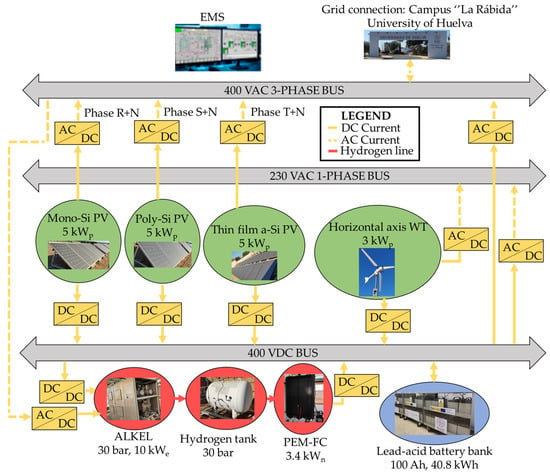
Figure 1.
Configuration of the microgrid under study.
The microgrid, depicted in Figure 1, supplies tens of kW of RES, as well as a battery bank (of tens of kWh) and a hydrogen subsystem (consisting of an electrolyser, a hydrogen-storage tank and a fuel cell) of several kW. To connect the different elements of the microgrid, a high voltage DC bus (400 VDC) will be the backbone of the microgrid, allowing it to exchange power between different sources. This DC bus is directly connected to the battery bank, avoiding problems related to reactive power [26], and ensuring its stability [27]. RES systems, the electrolyser and the fuel cell are connected through DC/DC converters. In addition, the microgrid includes a single-phase 230 VAC bus (which is connected to the 400 VDC bus and to the wind turbine through DC/AC converters) and a three-phase 400 VAC bus (which is connected to the 400 VDC bus and to the three technologies of the photovoltaic systems through DC/AC converters, to the electrolyser through an AC/DC converter and to the main grid directly) which allow RES production to power AC loads. All the power electronics, instrumentations and the EMS-software interface (developed in MATLAB® R2019a), shown in Figure 1, have been developed by the authors [28].
2.1. Microgrid Elements
The different elements integrated in the microgrid are described in more detail below.
- -
- Solar PV panels: A total of 15 kW of solar PV panels of three different technologies (monocrystalline, polycrystalline and Si-based amorphous thin-film technology), each with 5 kWp, are used to produce RES-based energy to supply the load demand.
- -
- Wind Turbine (WT): A 3 kWe horizontal-axis wind turbine is also used to produce the energy needed to contribute to the load demand.
- -
- Alkaline electrolyser (ALKEL): A 10 kWe alkaline electrolyser is used to produce hydrogen, at 30 bar, from water at excess-energy times (i.e., when energy production is higher than load demand).
- -
- Proton-exchange-membrane fuel cell (PEM-FC): A 3.4 kWn PEM-FC is used to produce electrical energy at energy-deficit times (i.e., when load demand is higher than RES-origin production).
- -
- Compressed hydrogen-storage tank: A hydrogen tank with a volume of 1.044 m3 and a nominal pressure of 30 bar is used to store the hydrogen produced in the ALKEL.
- -
- Lead-acid battery bank: A bank of 34 lead-acid batteries (each with a capacity of 100 Ah and 12 V) with a total energy-storage capacity of 40.8 kWh is also used to store energy in times of energy surplus, which can be used later in times of energy deficit.
To synthesise the characteristics of the elements of the microgrid, previously described, Table 2 provides a summary of their technical parameters.

Table 2.
Summary of the technical parameters of the different elements of the microgrid.
2.2. Energy-Management Systems (EMSs) Implemented
Once the microgrid is in operation, it is necessary to set up an EMS that decides which element to use and when in times of power surplus, whether the electrolyser, to produce hydrogen and thus store energy in chemical form, or the battery bank, to store the energy in electrochemical form. Likewise, in times of power deficit, the EMS must decide whether to activate the PEM-FC, which will transform the chemical energy of hydrogen into electrical energy, or the battery bank, to provide electrical energy. Thus, two EMSs will be defined by (1):
where is net power (kW), is RES-based power (kW) and is load power (kW).
The sign criterion adopted considers that a negative value for power () means power extracted from the DC bus, while a positive value () means power injected into the DC bus. Based on Equation (1), Equation (2) will also help in decision making in the two EMSs implemented:
where is the total power balance of the DC bus (kW), which must always be 0; is the power (kW) injected into the main grid, extracted from the DC bus () or extracted from the main grid and injected into the DC bus (); is the power (kW) extracted from the DC bus to supply the electrolyser () or power injected into the DC bus through the fuel cell (); is the power (kW) extracted from the DC bus to charge the battery bank () or power injected into the DC bus during battery-bank discharge ().
- Hydrogen-priority strategy: This EMS aims to prioritise the use of hydrogen systems over battery bank. Thus, in excess-power moments (), the use of the ALKEL will be prioritised over the use of battery banks. As long as hydrogen-tank pressure () is between minimum pressure () and 30 bar (maximum pressure, ), and as long as the excess power will be used to produce hydrogen. In other cases, (i.e., ) while the battery’s state of charge (SOC) is between its minimum ( = 20%) and its maximum ( = 80%) values, apart from producing hydrogen, the surplus power will be used to charge the battery bank, and ultimately, to inject power into the main grid.
At power-deficit moments (), while , the load demand will be ensured, in the first instance, by the electricity production in the fuel cell (if . If the load demand is higher than nominal-fuel-cell power, and the battery bank has enough energy stored (), the load demand will be supplied by both the fuel cell and battery. Finally, it will be necessary to take energy from the main grid when there is not enough stored hydrogen () or the battery bank is discharged ().
- Battery-priority strategy: In this case, this EMS intends to prioritise the use of the battery bank over the hydrogen system. Thus, in excess-power moments (), the use of the battery will be prioritised over the ALKEL, so that as long as , while , the excess power will be used to charge the entire battery bank. If the latter condition is not fulfilled (i.e., ) while , the power excess will be used, separate from charging the battery bank, to produce hydrogen in the electrolyser, or even, if the net excess is higher than the electrolyser and battery-bank demand ( the surplus will be dumped for use in the main grid.
Regarding power-deficit moments (), while , the load demand will be ensured firstly using the battery bank (if , then using the battery bank and the fuel cell if there is enough hydrogen stored (), and finally, if it is necessary, using the main grid (if ).
The two EMSs described above are summarised in Figure 2.
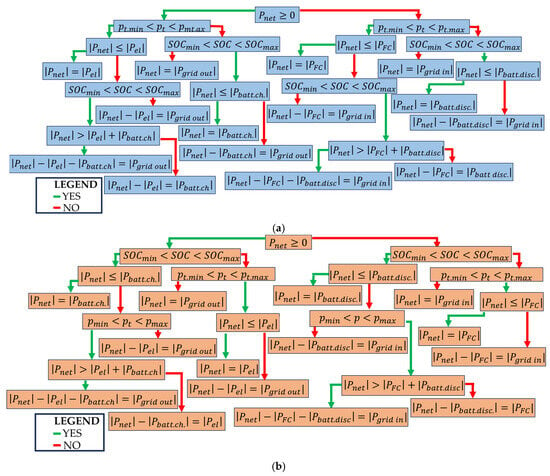
Figure 2.
Outline of (a) H2-priority EMS and (b) battery-priority EMS.
Although a hydrogen-priority EMS has greater independence from the main grid than a battery-priority EMS, it makes greater use of hydrogen-based equipment, which implies greater degradation of the equipment and that a higher number of replacements are required during the lifetime of the microgrid, which will affect the profitability of the microgrid.
3. Cost-Effectiveness Analysis over Microgrid Lifespan
In this section, the cost-effectiveness of the hydrogen-based microgrid will be analysed in terms of the electricity price and cost reduction of a hydrogen-based system for both EMSs presented (hydrogen-priority strategy and battery-priority strategy). For this purpose, the lifespan of the microgrid has been considered to be 20 years [29].
The cost-effectiveness of the microgrid will depend on various factors: (1) the costs associated with the equipment, (2) the savings, thanks to RES-based energy production, and (3) the sale of energy surplus to the main grid. To study the profitability scenarios, we have considered a variation of the electricity purchase price from 0.01 EUR/kWh to 3 EUR/kWh. Based on the literature [29], an electricity purchase fee of 0.136 EUR/kWh, and an electricity sale rate of 0.030 EUR/kWh have been assumed. To reach a normalised selling/buying price based on main-grid electricity prices, the conversion factor shown in Equation (3), has been used:
where is the unit cost of selling electricity from the microgrid to the main grid (EUR/kWh), and is the unit cost of buying electricity from the main grid for the microgrid (EUR/kWh).
As mentioned above, the cost of electricity purchase, or , varies from 0.01 EUR/kWh to 3 EUR/kWh, so will be a function of this fee.
The reason for this wide range is due to a huge instability of domestic electricity prices [30,31]. Thus, for Q3 2022, the average electricity prices were 27.33 cEUR/kWh for the 27 countries of the EU as a whole, with prices ranging from 7.77 cEUR/kWh to 54.65 cEUR/kWh (Netherlands: 7.77 cEUR/kWh, Hungary: 10.59 cEUR/kWh, Poland: 14.66 cEUR/kWh, Greece: 18.71 cEUR/kWh, France: 21.59 cEUR/kWh, Spain: 33.07 cEUR/kWh, Germany: 33.17 cEUR/kWh, Italy: 36.18 cEUR/kWh, Denmark: 54.65 cEUR/kWh, among others). Meanwhile, for Q4 2022 the average electricity price was 29.49 cEUR/kWh for EU countries as a whole, with prices ranging from 8.35 cEUR/kWh to 62.41 cEUR/kWh (Netherlands: 8.35 cEUR/kWh, Hungary: 12.19 cEUR/kWh, Poland: 14.66 cEUR/kWh, Greece: 17.07 cEUR/kWh, France: 21.73 cEUR/kWh, Spain: 21.86 cEUR/kWh, Germany: 35.86 cEUR/kWh, Italy: 61.21 cEUR/kWh, Denmark: 62.41 cEUR/kWh, among others) [32].
The cost-effectiveness analysis to be performed requires knowledge of the amount of energy supplied by the microgrid and injected into the main grid, and the amount of energy purchased from the main grid. These data have been obtained from a previous study [33] and are shown in Table 3. Taking these data into account, Equation (4) finds the savings over the lifespan of the microgrid. Savings are calculated as the addition of non-expenditure associated with energy produced by the microgrid itself, and the revenue from selling the energy surplus to the main grid. This is the amount on which the cost of purchasing electricity from the main grid must be based in times of energy-deficit. Figure 3 shows the savings obtained from each EMS.
where are the total savings of the microgrid (EUR); is the energy saved annually, i.e., energy that is not bought from main grid (kWh); is the energy injected into the main grid annually (kWh); is the energy obtained from the main grid annually (kWh); and is the lifespan of the microgrid (20 years).

Table 3.
Annual energy savings, grid out and grid in energy for both EMSs.
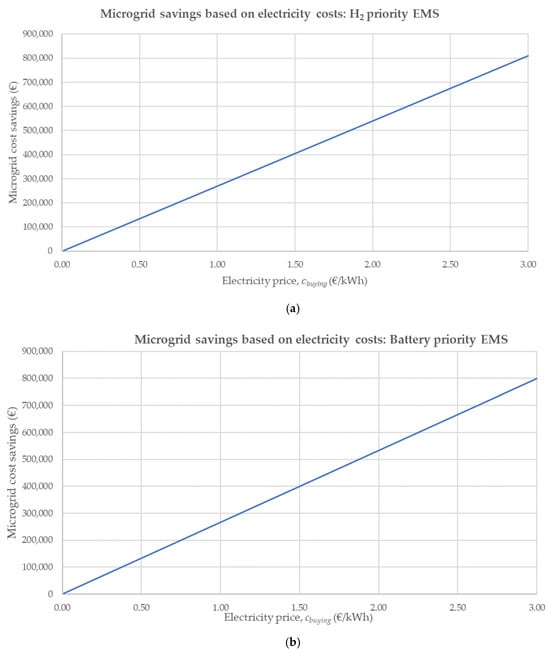
Figure 3.
Microgrid cost savings based on electricity costs for (a) H2-priority EMS, (b) battery-priority EMS.
The microgrid subject to study will be profitable if the savings are higher than the project expenses, which are due to investment costs and operation and maintenance (O and M) costs. Since the studied microgrid has integrated hydrogen-based systems, the total costs associated with the microgrid will be studied in terms of the cost reduction of hydrogen-based systems for both EMSs based on the data obtained from the aforementioned previous study [33], shown in Table 4. The cost reduction of the hydrogen-based systems subject to study varies from 0% (i.e., current costs) to 100%. Although the 100% cost-reduction scenario is not realistic, it has been included in the study in order to give an overview of the costs, benefits and profitability of the project in terms of cost reduction. Nevertheless, if the same cost reduction that occurred from 1983 to 2019 for wind power (72% [11]) is inferred to H2 systems, the microgrid will be much more profitable (so it is even better to consider, for a huge study, more optimistic scenarios). Thus, in Figure 4, the investment and O and M costs (that can be calculated thanks to Equations (5) and (6), respectively) are based on the cost reduction of H2 systems that can be observed.
where is the total investment cost (initial investment + replacements) based on the H2 systems’ cost-reduction scenario (EUR); is the forecast reduction of the H2 systems’ cost (%); is the total H2 systems’ investment costs (initial investment + replacements) for the 0% cost-reduction scenario (EUR); is the forecast reduction of battery+RES systems’ cost (%); is the total investment cost (initial investment + replacements) for the 0% cost-reduction scenario (EUR); is the total O and M cost based on the H2 systems’ cost-reduction scenario (EUR); is the total H2 systems’ O and M cost for the 0% cost-reduction scenario (EUR); is the total O and M cost for the 0% cost reduction (EUR).

Table 4.
Costs over microgrid lifespan for both EMSs in a cost-reduction scenario for H2 systems of 0% [33].
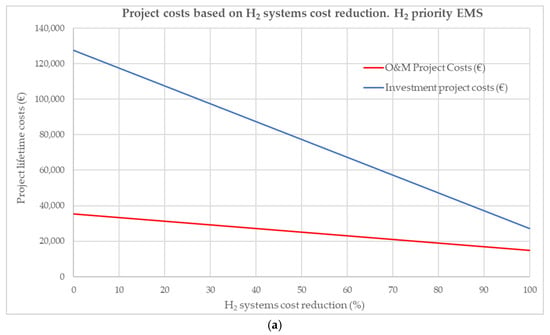
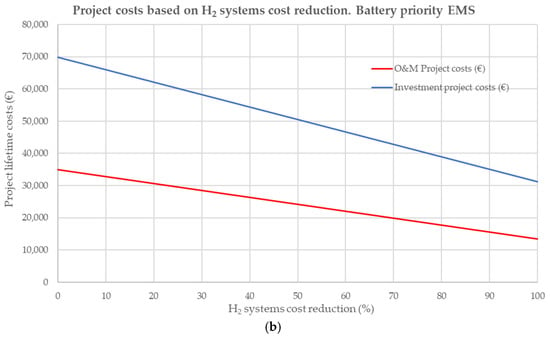
Figure 4.
Project costs based on H2 systems’ costs reduction for (a) H2-priority EMS, and (b) battery-priority EMS.
Figure 4 shows the project costs based on a forecast of H2 systems’ cost-reduction rate from 0% to 100%.
For each H2 system’s cost-reduction rate, there will be an electricity price at which the microgrid will be profitable (i.e., cost savings are greater than project costs). Table 5 shows the electricity price that makes the microgrid a profitable project as a function of the H2 systems’ cost reduction.

Table 5.
Electricity price from which the microgrid is profitable for both EMSs based on cost reduction of H2 systems.
As shown in Table 5, the electricity price at which the microgrid will be profitable for battery-priority EMSs will be lower than the respective price for H2-priority EMSs. However, the higher the H2 systems’ cost reduction, the lower the difference between the electricity price that makes the microgrid profitable for the two EMSs. This is depicted in Figure 5.

Figure 5.
Electricity price at which the microgrid becomes profitable, based on H2 systems’ cost reduction (Average Spanish electricity prices obtained from https://www.esios.ree.es/ (Consulted on 18 January 2023). On August 2022, Spanish electricity prices reached the highest value of the data history).
In addition, the project will lead to economic benefits if the electricity purchase price is higher than the cost-effective price, and economic losses if electricity purchase price is lower than the cost-effective price. Figure 6 shows the benefits of the project (over its lifespan) as a function of electricity prices (EUR/kWh) and H2 systems’ cost reduction (%) based on data obtained from a previous study [33] for both EMSs shown in Table 5.
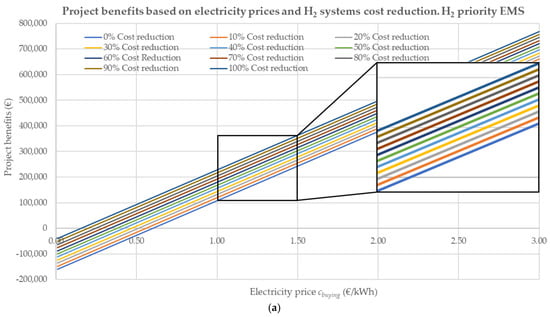
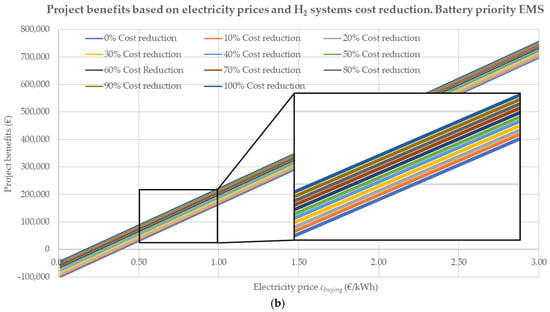
Figure 6.
Project benefits based on electricity prices and H2 systems’ cost reduction for (a) H2-priority EMS and (b) battery-priority EMS.
Additionally, as market trends show cost reductions in RES like wind and solar PV energy [11], and in battery systems [12], a new scenario has been included for profitability study, in which there will be a cost reduction in H2 systems and RES + battery systems (from 0 to 100%, to get an overview of the project benefits in the same way as previously done for H2 systems). Thus, Figure 7 shows the benefits of the project, in terms of a cost reduction for H2 systems and a cost reduction for RES + battery systems based on the data obtained from a previous study [33] and the electricity price, for both implemented EMS.
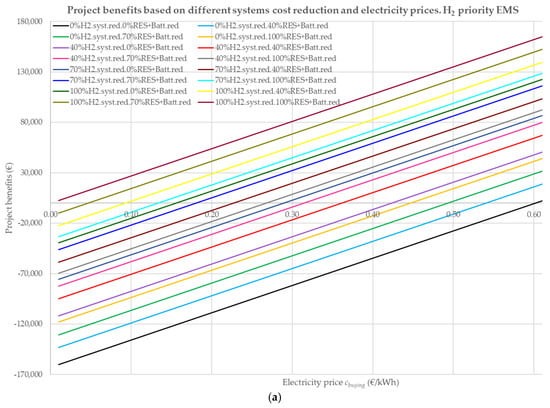
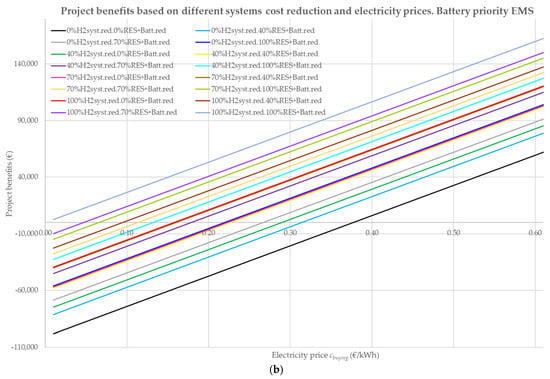
Figure 7.
Project benefits based on electricity prices, H2 systems’ cost reduction (0%, 40%, 70% and 100%) and RES + battery-system cost reduction (0%, 40%, 70% and 100%) for (a) H2-priority EMS and (b) battery-priority EMS.
As shown in Figure 7, whichever EMS is implemented, the higher the cost reduction of the systems that make up the microgrid, the greater the benefits to the microgrid. This will be higher for the battery-priority EMS, but the difference will narrow as the cost reduction of the systems increases to the point that, when this reduction is significant enough, the hydrogen-priority EMS will generate greater benefits for the microgrid.
4. Discussion
First of all, based on the cost–benefit analysis carried out in this study, it has been found that, for hydrogen-priority EMSs, the project cost savings are higher than for battery-priority EMSs regardless of the electricity price, as shown in Figure 3. Nevertheless, the project costs (on the one hand, initial investment and replacement costs and, on the other hand, O and M costs) associated with hydrogen-priority EMSs are also higher than for battery-priority EMSs. However, the difference narrows as the cost reduction of hydrogen systems continues (and in a utopian scenario of 100% hydrogen-system cost reduction, H2-priority EMSs will have lower associated costs), as shown in Figure 4. As a result, the electricity price at which the microgrid becomes profitable is considerably higher for the hydrogen-priority strategy than for the battery-priority strategy (specifically, for a 0% hydrogen-system cost-reduction scenario, it would be 0.61 EUR/kWh, compared to 0.4 EUR/kWh, respectively). But, this difference is reduced as hydrogen-system cost reduction continues. In the utopian scenario of 100% hydrogen-system cost reduction, there would be virtually no difference between the electricity price that would make the microgrid profitable for both EMSs. In fact, the cost-effective electricity price would be 0.16 EUR/kWh for H2-priority EMSs, compared to 0.17 EUR/kWh for battery-priority EMSs, as shown in Table 5 and Figure 5. If the economic benefits (or losses) are studied, based on the electricity price (EUR/kWh) and on hydrogen-system cost reduction (%), the result is that only scenarios with high electricity prices and high hydrogen-system cost reduction (at least, above 91%), then the hydrogen-priority EMS is more profitable than the battery-priority EMS. In the utopian scenario described above, the H2-priority EMS is always more profitable than the other, as shown in Figure 6. For example, in a scenario of 99% hydrogen-system cost reduction, for an electricity price from 0.31EUR/kWh, the benefits for hydrogen-priority EMSs would be higher. Finally, if a reduction in battery-bank and RES-based systems’ costs is also considered, a significantly lower cost-effective electricity price can be obtained. Nevertheless, that price will be higher for hydrogen-priority EMSs than for battery-priority EMSs (except in scenarios where both the electricity price and hydrogen-system cost reduction are high), as shown in Figure 7.
It should be noted that, although a 100% reduction in system costs is impossible, due to technological advances a slow decrease in equipment costs is happening, so the cost-effective-electricity price is expected to decrease significantly in the coming years. In fact, inferring from the same cost reduction that wind turbines have experienced since 1983 and until 2019, at 72% [11] for hydrogen systems and battery system + RES, the cost-effective electricity price would be 0.19 EUR/kWh for H2-priority EMSs and 0.12 EUR/kWh for battery-priority EMSs. Compared to the current scenario in Spain [30], in Q3 2022, when the electricity price was 33.07 cEUR/kWh [31] and 21.86 cEUR/kWh [32], in Q4 2022, they averaged, the aforementioned 70% reduction in systems’ cost would be more profitable than a scenario of full connection to the main grid for both EMSs. In any case, for battery-priority EMSs, in the desired scenario described, the electricity price at which the microgrid would be profitable (0.12 EUR/kWh) would be even lower than the electricity price before the current uncertain scenario (0.136 EUR/kWh [34]). Such a scenario would mean that a hydrogen-based microgrid can be an economically competitive solution, at a time when carbon dioxide emissions are avoided, as shown in Figure 8 [35].
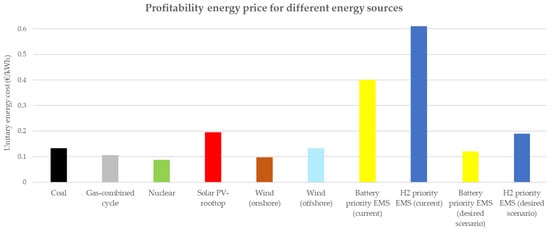
Figure 8.
Cost-effective energy price for different energy sources.
Beyond the cost-effectiveness study carried out in this paper, it should be noted that a renewable hydrogen-based microgrid can bring major environmental and social benefits. It is environmentally friendly because the renewable energy-based equipment that forms part of the microgrid has no associated carbon footprint, except in cases when the microgrid takes electricity from the main grid [33]. The social benefits are the possibility of creating new jobs associated with the operation and maintenance tasks of the equipment that make up these microgrids, as well as maintaining the health of the population living in the vicinity of these microgrids.
5. Conclusions
This paper has presented an economic profitability study of a hydrogen-based microgrid.
For a hydrogen-based microgrid to be implemented at a socioeconomic level, it is necessary to study the associated costs and benefits that can be obtained from it. Furthermore, the results obtained in this study can be transferred to other locations, as long as the renewable production profile, the consumption profile and the usage time (which, in turn, will depend on the implemented EMS) of each piece of the equipment that makes up the microgrid are taken into account. Moreover, it is crucial to study when electricity prices are high enough to make the microgrid profitable, both considering the price of buying and selling electricity and the cost reduction of H2 systems and RES + battery systems. Since the EMS implemented in a microgrid (responsible for its control) will determine the electricity price at which the microgrid will be profitable, two EMSs have been studied in this paper: hydrogen-priority strategy and battery-priority strategy.
Regarding the results obtained, although hydrogen-priority EMSs has higher cost savings than battery-priority EMSs, it also has much higher associated costs (due to more replacements). This implies that the cost-effective electricity price is significantly higher for this EMS, except in the utopian scenario where hydrogen-system cost reduction is 100% (in which it would be slightly lower). Nevertheless, the benefits of hydrogen-priority EMSs can be higher than for battery-priority EMSs for high electricity prices or high hydrogen-system cost reduction. This trend also occurs in the scenario where battery system + RES cost reduction (which supposes significantly lower cost-effective electricity prices) is included, where (unless hydrogen-system cost reduction and electricity prices are high), the battery-priority EMS offers greater benefits. However, it must not be forgotten that the present study has considered two EMSs: hydrogen-priority EMS and battery-priority EMS. Therefore, this study should be considered as a starting point to study in the future the price of electricity at which the microgrid becomes profitable for other different EMSs.
This analysis of the cost-effectiveness of a hydrogen-based microgrid has clear policy implications. At a time of fluctuating energy prices, a large investment in research and development is key to reduce the costs of systems (both hydrogen systems and battery + RES systems) to the point where a microgrid configuration as described above is cost-effective compared to a permanent home connected to the main electricity grid. Although this scenario may seem distant, the truth is that, as of today (0% cost reduction scenario), the battery-priority strategy is not too far from being profitable from an economic point of view, taking into account the outlook for electricity prices, as from an electricity price of 40 cEUR/kWh, it would achieve this objective (this price has been close to being reached recently in Spain in Q3 2022, 33.07 cEUR/kWh). Finally, from the authors’ point of view, this paper has made a key economic analysis that will help policy decisions in the field of hydrogen-based microgrid implementation.
Author Contributions
Conceptualization, J.R.; methodology, J.R. and F.S.; validation, J.R.; formal analysis, J.R. and F.S.; investigation, J.R.; resources, J.M.A.; data curation, J.R.; writing—original draft preparation, J.R., F.S. and J.M.A.; writing—review and editing, J.R. and F.S.; visualization, J.R.; supervision, F.S. and J.M.A.; project administration, J.M.A.; funding acquisition, J.M.A. All authors have read and agreed to the published version of the manuscript.
Funding
This research was funded by the Spanish Government, grant (1) Ref: PID2020-116616RBC31 and grant (2) Ref: RED2022-134588-T REDGENERA.
Data Availability Statement
Data are available on request from corresponding authors.
Acknowledgments
This research was possible thanks to the work of Andrea Monforti Ferrario, who developed the software with which a simulation of the described microgrid was performed, which subsequently led to the profitability study carried out in this paper.
Conflicts of Interest
The authors declare no conflict of interest.
Abbreviations
| List of Acronyms | |
| ALKEL | Alkaline Electrolyser |
| EMS | Energy-Management System |
| ESS | Energy-Storage System |
| EU | European Union |
| FC | Fuel Cell |
| kWe | Electrical kilowatts |
| kWn | Nominal kilowatts |
| kWp | Peak kilowatts |
| LCOE | Levelised Cost Of Energy |
| LSP | Luminescent Solar Power |
| MILP | Mixed-Integer Linear Programming |
| O&M | Operation and Maintenance |
| PEM-FC | Proton-Exchange-Membrane Fuel Cell |
| PL | Photoluminescent |
| PV | Photovoltaic |
| RFB | Redox Flow Batteries |
| RES | Renewable Energy Source |
| SOC | State of Charge |
| WT | Wind Turbine |
| Notation and symbols | |
| Unit cost of buying electricity frfom the main grid (EUR/kWh) | |
| Investment costs of H2 systems (initial investment + replacements) for the 0% cost reduction scenario (EUR) | |
| Total investment costs (initial investment +replacements) for the 0% cost reduction scenario (EUR) | |
| Total investment (initial investment + replacements) costs based on H2 systems cost reduction scenario (EUR) | |
| O and M costs of H2 systems for the 0% cost-reduction scenario (EUR) | |
| Total O and M costs for the 0% cost reduction (EUR) | |
| Total O and M costs based on the H2 systems cost-reduction scenario (EUR) | |
| Total saving costs of the microgrid (EUR) | |
| Unit cost of selling electricity to the main grid (EUR/kWh) | |
| Energy obtained from the main grid annually (kWh) | |
| Energy injected into the main grid annually (kWh) | |
| Energy saved annually, i.e., energy not bought from main grid (kWh) | |
| Battery-bank power (kW) | |
| Power (kW) extracted from DC bus to charge the battery () | |
| Power (kW) injected into DC bus by the battery bank () | |
| Power (kW) extracted from DC bus to supply the electrolyser () | |
| Power (kW) injected into the DC bus by the fuel cell () | |
| Power exchanged with the main grid (kW) | |
| Power (kW) injected into DC bus from the main grid () | |
| Power (kW) injected into main grid by the DC bus () | |
| Hydrogen-based systems power (kW) | |
| Load power (kW) | |
| Net power (kW) | |
| RES-based power (kW) | |
| Total power balance on the DC bus (kW) | |
| Hydrogen-tank pressure (Pa) | |
| Maximum hydrogen-tank pressure (30 bar) | |
| Minimum hydrogen-tank pressure (1 bar) | |
| Battery+RES systems cost-reduction rate (%) | |
| H2 systems cost-reduction rate (%) | |
| Maximum battery state of charge (20%) | |
| Minimum battery state of charge (80%) | |
| Lifespan of the microgrid (20 years) | |
References
- Lee, B.; Choe, C.; Kim, H.; Kim, A.; Shin, Y.U.; Haider, J.; Lim, H. Economic Parity Analysis of Green Methanol Synthesis Using Water Electrolysis Based on Renewable Energy. ACS Sustain. Chem. Eng. 2021, 9, 15807–15818. [Google Scholar] [CrossRef]
- Liu, Y.; He, Q.; Shi, X.; Zhang, Q.; An, X. Energy storage in China: Development progress and business model. J. Energy Storage 2023, 72, 108240. [Google Scholar] [CrossRef]
- Eremeeva, A.M.; Ilyushin, Y.V. Automation of the control system for drying grain crops of the technological process for obtaining biodiesel fuels. Sci. Rep. 2023, 13, 14956. [Google Scholar] [CrossRef] [PubMed]
- Amir, M.; Deshmukh, R.G.; Khalid, H.M.; Said, Z.; Raza, A.; Muyeen, S.M.; Nizami, A.-S.; Elavarasan, R.M.; Saidur, R.; Sopian, K. Energy storage technologies: An integrated survey of developments, global economical/environmental effects, optimal scheduling model, and sustainable adaption policies. J. Energy Storage 2023, 72, 108694. [Google Scholar] [CrossRef]
- Shen, F.; Zhao, L.; Du, W.; Zhong, W.; Peng, X.; Qian, F. Data-Driven Stochastic Robust Optimization for Industrial Energy System Considering Renewable Energy Penetration. ACS Sustain. Chem. Eng. 2022, 10, 3690–3703. [Google Scholar] [CrossRef]
- Zhang, S.; Li, Y.; Du, E.; Fan, C.; Wu, Z.; Yao, Y.; Liu, L.; Zhang, N. A review and outlook on cloud energy storage: An aggregated and shared utilizing method of energy storage system. Renew. Sustain. Energy Rev. 2023, 185, 113606. [Google Scholar] [CrossRef]
- Scott, A. Counting the ways to store renewable energy. C&EN Glob. Enterp. 2018, 96, 14–17. [Google Scholar] [CrossRef]
- Shatnawi, M.; AlJaberi, N.S.A.M.; Al Qaydi, N.A.S.M. Solar-hydrogen microgrid project. In Proceedings of the SEG/AAPG/EAGE/SPE Research and Development Petroleum Conference and Exhibition 2018, Abu Dhabi, United Arab Emirates, 9–10 May 2018. [Google Scholar]
- Van, L.P.; Do Chi, K.; Duc, T.N. Review of hydrogen technologies based microgrid: Energy management systems, challenges and future recommendations. Int. J. Hydrogen Energy 2023, 48, 14127–14148. [Google Scholar] [CrossRef]
- Hanley, E.S.; Amarandei, G.; Glowacki, B.A. Potential of Redox Flow Batteries and Hydrogen as Integrated Storage for Decentralized Energy Systems. Energy Fuels 2016, 30, 1477–1486. [Google Scholar] [CrossRef]
- IRENA Agency. Renewable Power Generation Costs in 2019; International Renewable Energy Agency: Masdar City, United Arab Emirates, 2020. [Google Scholar]
- Hydrogen Council. Path to Hydrogen Competitiveness A Cost Perspective; Hydrogen Council: Brussels, Belgium, 2020. [Google Scholar]
- Vaishnav, P.; Horner, N.; Azevedo, I.L. Was it worthwhile? Where have the benefits of rooftop solar photovoltaic generation exceeded the cost? Environ. Res. Lett. 2017, 12, 094015. [Google Scholar] [CrossRef]
- Reisch, M. The coming challenge of green hydrogen. C&EN Glob. Enterp. 2020, 98, 28. [Google Scholar] [CrossRef]
- Nykvist, B.; Nilsson, M. Rapidly falling costs of battery packs for electric vehicles. Nat. Clim. Chang. 2015, 5, 329–332. [Google Scholar] [CrossRef]
- Ming Kwok, J.J.; Yu, N.; Karimi, I.A.; Lee, D.Y. Microgrid scheduling for reliable, cost-effective, and environmentally friendly energy management. Ind. Eng. Chem. Res. 2013, 52, 142–151. [Google Scholar] [CrossRef]
- Zhu, Z.; Weng, Z.; Zheng, H. Optimal Operation of a Microgrid with Hydrogen Storage Based on Deep Reinforcement Learning. Electronics 2022, 11, 196. [Google Scholar] [CrossRef]
- Haviv, S.; Revivo, N.; Kruger, N.; Manor, A.; Khachatryan, B.; Shustov, M.; Rotschild, C. Luminescent Solar Power—PV/Thermal Hybrid Electricity Generation for Cost-Effective Dispatchable Solar Energy. ACS Appl. Mater. Interfaces 2020, 12, 36040–36045. [Google Scholar] [CrossRef]
- Lai, Y.Y.; Li, X.; Zhu, Y. Polymeric Active Materials for Redox Flow Battery Application. ACS Appl. Polym. Mater. 2020, 2, 113–128. [Google Scholar] [CrossRef]
- Krajačić, G.; Duić, N.; da Graça Carvalho, M. H2RES, Energy planning tool for island energy systems—The case of the Island of Mljet. Int. J. Hydrogen Energy 2009, 34, 7015–7026. [Google Scholar] [CrossRef]
- Grosspietsch, D.; Thömmes, P.; Girod, B.; Hoffmann, V.H. How, When, and Where? Assessing Renewable Energy Self-Sufficiency at the Neighborhood Level. Environ. Sci. Technol. 2018, 52, 2339–2348. [Google Scholar] [CrossRef]
- Mah, A.X.Y.; Ho, W.S.; Hassim, M.H.; Hashim, H.; Ling, G.H.T.; Ho, C.S.; Muis, Z.A. Optimization of a standalone photovoltaic-based microgrid with electrical and hydrogen loads. Energy 2021, 235, 121218. [Google Scholar] [CrossRef]
- Vincent, R.; Houari, A.; Ait-Ahmed, M.; Benkhoris, M.F. Influence of different time horizon-based battery energy management strategies on residential microgrid profitability. J. Energy Storage 2020, 29, 101340. [Google Scholar] [CrossRef]
- Azimian, M.; Amir, V.; Mohseni, S.; Brent, A.C.; Bazmohammadi, N.; Guerrero, J.M. Optimal Investment Planning of Bankable Multi-Carrier Microgrid Networks. Appl. Energy 2022, 328, 120121. [Google Scholar] [CrossRef]
- Eskander, M.M.; Silva, C.A. Techno-economic and environmental comparative analysis for DC microgrids in households: Portuguese and French household case study. Appl. Energy 2023, 349, 121495. [Google Scholar] [CrossRef]
- Vivas, F.J.; De las Heras, A.; Segura, F.; Andújar, J.M. A review of energy management strategies for renewable hybrid energy systems with hydrogen backup. Renew. Sustain. Energy Rev. 2018, 82, 126–155. [Google Scholar] [CrossRef]
- Vivas, F.J.; Segura, F.; Andújar, J.M. Fuzzy logic-based energy management system for grid-connected residential DC microgrids with multi-stack fuel cell systems: A multi-objective approach. Sustain. Energy Grids Netw. 2022, 32, 100909. [Google Scholar] [CrossRef]
- Andújar, J.M.; Vivas, F.J.; Segura, F.; Calderón, A.J. Integration of air-cooled multi-stack polymer electrolyte fuel cell systems into renewable microgrids. Int. J. Electr. Power Energy Syst. 2022, 142, 108305. [Google Scholar] [CrossRef]
- Monforti Ferrario, A.; Bartolini, A.; Segura Manzano, F.; Vivas, F.J.; Comodi, G.; McPhail, S.J.; Andujar, J.M. A model-based parametric and optimal sizing of a battery/hydrogen storage of a real hybrid microgrid supplying a residential load: Towards island operation. Adv. Appl. Energy 2021, 3, 100048. [Google Scholar] [CrossRef]
- Market Observatory for Energy. Quarterly Report on European Electricity Markets: With Focus on the Impact of Wholesale Electricity Prices on Household Retail Prices; Covering Third Quarter of 2021; European Commission: Brussels, Belgium, 2022; Volume 14. [Google Scholar]
- Market Observatory for Energy. Quarterly Report on European Electricity Markets; Covering Third Quarter of 2022; European Commission: Brussels, Belgium, 2023; Volume 15. [Google Scholar]
- Market Observatory for Energy. Quarterly Report on European Electricity Markets: With Focus on Price Developments in 2022; Covering Fourth Quarter of 2022; European Commission: Brussels, Belgium, 2023; Volume 15. [Google Scholar]
- Rey, J.; Segura, F.; Andújar, J.M.; Ferrario, A.M. The Economic Impact and Carbon Footprint Dependence of Energy Management Strategies in Hydrogen-Based Microgrids. Electronics 2023, 12, 3703. [Google Scholar] [CrossRef]
- Vivas, F.J.; Segura, F.; Andújar, J.M.; Caparrós, J.J. A suitable state-space model for renewable source-based microgrids with hydrogen as backup for the design of energy management systems. Energy Convers. Manag. 2020, 219, 113053. [Google Scholar] [CrossRef]
- Schlömer, S.; Bruckner, T.; Fulton, L.; Hertwich Austria, E.; McKinnon, A.U.; Perczyk, D.; Roy, J.; Sims, R.; Smith, P.; Wiser, R.; et al. III ANNEX Technology-Specific Cost and Performance Parameters. In Fifth Assessment Report of the Intergovernmental Panel on Climate Change; Cambridge University Press: Cambridge, UK; New York, NY, USA, 2014. [Google Scholar]
Disclaimer/Publisher’s Note: The statements, opinions and data contained in all publications are solely those of the individual author(s) and contributor(s) and not of MDPI and/or the editor(s). MDPI and/or the editor(s) disclaim responsibility for any injury to people or property resulting from any ideas, methods, instructions or products referred to in the content. |
© 2023 by the authors. Licensee MDPI, Basel, Switzerland. This article is an open access article distributed under the terms and conditions of the Creative Commons Attribution (CC BY) license (https://creativecommons.org/licenses/by/4.0/).